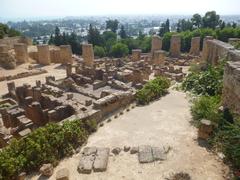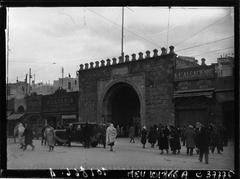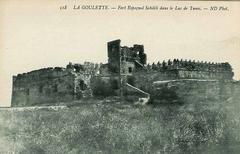Madrasa of El Bachia: Visiting Hours, Tickets, and Complete Guide to Tunis’s Historical Gem
Date: 04/07/2025
Introduction: Why the Madrasa of El Bachia is Essential to Tunis’s Heritage
Tucked within the winding alleys of the historic Medina of Tunis, the Madrasa of El Bachia stands as an enduring symbol of the city’s Islamic educational legacy and architectural artistry. Founded in the 18th century during the Husainid dynasty, and influenced by earlier Hafsid and Ottoman traditions, El Bachia was more than just a school—it was a hub for religious learning, community life, and cultural craftsmanship. Today, it continues to play a vital role as a preserved monument, artisan space, and a portal into Tunisia’s vibrant past (Wikipedia; Very Hungry Nomads; Carthage Magazine).
Table of Contents
- Historical Foundations and Patronage
- Educational Role and Curriculum
- Architectural Features and Urban Context
- Transformation and Adaptive Reuse
- Visitor Guide: Hours, Tickets, Accessibility, and Tours
- Cultural Etiquette and Practical Tips
- Nearby Attractions in the Medina of Tunis
- Frequently Asked Questions (FAQ)
- Summary and Key Highlights
- References
Historical Foundations and Patronage
El Bachia’s origins trace back to the 18th century, part of a broader movement to expand Islamic learning in Tunis. Established as a waqf (charitable endowment), the madrasa was sustained by donors from the royal and elite classes, ensuring ongoing funding for teachers and student stipends. Its creation contributed to a centuries-old tradition of madrasas in the city, dating to the Hafsid dynasty, and reinforced Tunis’s status as a center for scholarship and civic leadership (Wikipedia; Tunisiefocus).
Educational Role and Curriculum
Historically, El Bachia provided comprehensive religious and legal education, including Quranic studies, Hadith, Fiqh, Arabic literature, and, at times, disciplines like logic and astronomy. The madrasa’s faculty often comprised esteemed scholars from the Zaytuna Mosque-University, and the curriculum reflected both Maliki and Ottoman Hanafi traditions. Students, some traveling from distant parts of Tunisia, benefited from free lodging and sometimes meals, fostering accessibility to higher learning and facilitating social mobility (Tunisiefocus).
Architectural Features and Urban Context
El Bachia’s architecture showcases a harmonious blend of Ottoman and Tunisian styles. The defining features include:
- Central Courtyard: The heart of the madrasa, with zellij tilework and a tranquil atmosphere.
- Student Rooms: Arranged around the courtyard, these modest chambers once housed scholars-in-residence.
- Prayer Hall: Adorned with intricate stucco, carved wood, and a beautifully decorated mihrab.
- Decorative Details: Geometric and floral zellij tiles, calligraphic inscriptions, and elegant arches supported by slender columns (Carthage Magazine; Archiqoo).
Located on Rue des Libraires, El Bachia sits near key Medina landmarks such as the Zitouna Mosque, forming part of the UNESCO-listed urban fabric of the old city (Carthage Magazine).
Transformation and Adaptive Reuse
With the modernization of Tunisia’s educational system in the 20th century, the traditional teaching function of madrasas waned. However, El Bachia found new life as a residence for university students and, more recently, as a space for artisan workshops. This adaptive reuse preserves the building’s integrity while supporting the continuation of traditional crafts and community engagement (Carthage Magazine; Journalspub; Academia.edu).
Visitor Guide: Hours, Tickets, Accessibility, and Tours
Opening Hours
- Generally open Tuesday to Sunday, from 9:00 AM to 5:00 PM.
- Closed Mondays and major public or religious holidays.
- Hours may vary depending on restoration work or special events; confirm with local tourism sources before visiting.
Tickets and Admission
- Admission is typically free, especially when visiting artisan workshops.
- Guided tours are available (often for a fee), offering deeper historical and architectural context.
- Some sources cite a nominal entry fee (about 10 Tunisian Dinars), particularly for organized tours or special events. Discounts may apply to students and seniors.
Accessibility
- Access is by foot through the Medina’s narrow, bustling streets.
- The historic structure presents challenges for those with mobility impairments; ramps are present at main entrances, but some areas have uneven surfaces.
- Assistance is recommended for visitors with limited mobility.
Guided Tours and Booking
- Guided tours are highly recommended and best arranged through certified local operators or tourism offices.
- Tours often include other major sites in the Medina, such as the Zitouna Mosque and nearby souks.
Cultural Etiquette and Practical Tips
- Dress modestly, covering shoulders and knees, to respect the religious and cultural context.
- Photography is allowed, but always seek permission before photographing people or artisans at work.
- Greeting locals with “Salam Alaikum” is appreciated.
- Respect quiet and refrain from touching delicate architectural features.
- Donations to support artisans and maintenance are welcome.
- Best visiting seasons: Spring (March–May) and autumn (September–November) offer pleasant weather.
Nearby Attractions in the Medina of Tunis
- Zitouna Mosque: Spiritual and architectural heart of Tunis.
- Dar Bach Hamba: Restored palace showcasing traditional interiors.
- Souks: Bustling markets for textiles, spices, and handicrafts.
- Other madrasas: Such as Slimania and Mouradiya, each with distinct histories and designs.
Frequently Asked Questions (FAQ)
Q: What are the Madrasa of El Bachia’s visiting hours?
A: Typically, Tuesday–Sunday, 9:00 AM–5:00 PM. Confirm in advance, especially during holidays.
Q: Is there an entrance fee?
A: Admission is usually free, but guided tours may charge a fee (approx. 10 Tunisian Dinars).
Q: Is the site accessible for people with disabilities?
A: Accessibility is limited; some ramps are present, but uneven surfaces remain.
Q: Are guided tours available?
A: Yes, through local tourism offices and certified guides.
Q: Can I take photographs inside?
A: Yes, but ask permission before photographing people or artisans.
Q: What is the best time to visit?
A: Daytime hours in spring or autumn; Ramadan may affect opening times and activities.
Summary and Key Highlights
The Madrasa of El Bachia is a living testament to Tunis’s Islamic educational traditions, architectural excellence, and community spirit. With its beautifully preserved Ottoman and Tunisian design elements, accessible visiting hours, and dynamic artisan activity, El Bachia offers a rich, immersive experience for travelers. Whether you explore independently or with a guide, your visit supports the ongoing preservation of this UNESCO-listed heritage site and the artisans who keep its spirit alive (Wikipedia; Carthage Magazine; Tunisiefocus; Very Hungry Nomads).
For seamless planning, download the Audiala app for maps, audio guides, and current information. Stay connected through official tourism channels and social media to enrich your journey through Tunisia’s captivating heritage (Audiala).
References
- Madrasas of Tunis, Wikipedia
- Les anciennes Madrasa de Tunis, Tunisiefocus
- Medina of Tunis, Carthage Magazine
- 10 Best Tips for Travel in Tunisia, Very Hungry Nomads
- Madrasa El Bachia Architectural Details, Archiqoo
- Challenges to Implementation of Adaptive Reuse of Heritage Buildings, Journalspub
- Adaptive Reuse of Historic Building, Academia.edu
- Official Medina of Tunis Tourism Website


